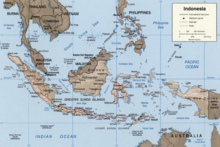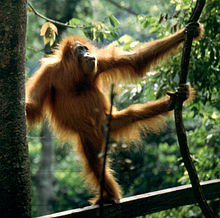Geography
Main article: Geography of Indonesia
Indonesia lies between latitudes 11°S and 6°N, and longitudes 95°E and 141°E. It consists of 17,508 islands, about 6,000 of which are inhabited.These are scattered over both sides of the equator. The largest are Java, Sumatra, Borneo (shared with Brunei and Malaysia), New Guinea (shared with Papua New Guinea), and Sulawesi. Indonesia shares land borders with Malaysia on Borneo, Papua New Guinea on the island of New Guinea, and East Timor on the island of Timor. Indonesia shares maritime borders across narrow straits with Singapore, Malaysia, and the Philippines to the north, and with Australia to the south. The capital, Jakarta, is on Java and is the nation's largest city, followed by Surabaya, Bandung, Medan, and Semarang.At 1,919,440 square kilometers (741,050 sq mi), Indonesia is the world's 16th-largest country in terms of land area.[70] Its average population density is 134 people per square kilometer (347 per sq mi), 79th in the world,[71] although Java, the world's most populous island,[72] has a population density of 940 people per square kilometer (2,435 per sq mi). At 4,884 metres (16,024 ft), Puncak Jaya in Papua is Indonesia's highest peak, and Lake Toba in Sumatra its largest lake, with an area of 1,145 square kilometers (442 sq mi). The country's largest rivers are in Kalimantan, and include the Mahakam and Barito; such rivers are communication and transport links between the island's river settlements.[73]

Mount Semeru and Mount Bromo in East Java. Indonesia's seismic and volcanic activity is among the world's highest.
Lying along the equator, Indonesia has a tropical climate, with two distinct monsoonal wet and dry seasons. Average annual rainfall in the lowlands varies from 1,780–3,175 millimeters (70–125 in), and up to 6,100 millimeters (240 in) in mountainous regions. Mountainous areas—particularly in the west coast of Sumatra, West Java, Kalimantan, Sulawesi, and Papua—receive the highest rainfall. Humidity is generally high, averaging about 80%. Temperatures vary little throughout the year; the average daily temperature range of Jakarta is 26–30 °C (79–86 °F).[77]
[edit] Biota and environment
Indonesia's size, tropical climate, and archipelagic geography, support the world's second highest level of biodiversity (after Brazil),[78] and its flora and fauna is a mixture of Asian and Australasian species.[79] The islands of the Sunda Shelf (Sumatra, Java, Borneo, and Bali) were once linked to the Asian mainland, and have a wealth of Asian fauna. Large species such as the tiger, rhinoceros, orangutan, elephant, and leopard, were once abundant as far east as Bali, but numbers and distribution have dwindled drastically. Forests cover approximately 60% of the country.[80] In Sumatra and Kalimantan, these are predominantly of Asian species. However, the forests of the smaller, and more densely populated Java, have largely been removed for human habitation and agriculture. Sulawesi, Nusa Tenggara, and Maluku—having been long separated from the continental landmasses—have developed their own unique flora and fauna.[81] Papua was part of the Australian landmass, and is home to a unique fauna and flora closely related to that of Australia, including over 600 bird species.[82]Indonesia is second only to Australia in terms of total endemic species, with 36% of its 1,531 species of bird and 39% of its 515 species of mammal being endemic.[83] Indonesia's 80,000 kilometers (50,000 mi) of coastline are surrounded by tropical seas that contribute to the country's high level of biodiversity. Indonesia has a range of sea and coastal ecosystems, including beaches, sand dunes, estuaries, mangroves, coral reefs, sea grass beds, coastal mudflats, tidal flats, algal beds, and small island ecosystems.[8] Indonesia is one of Coral Triangle countries with the world's greatest diversity of coral reef fish with more than 1,650 species in eastern Indonesia only.[84] The British naturalist, Alfred Wallace, described a dividing line between the distribution and peace of Indonesia's Asian and Australasian species.[85] Known as the Wallace Line, it runs roughly north-south along the edge of the Sunda Shelf, between Kalimantan and Sulawesi, and along the deep Lombok Strait, between Lombok and Bali. West of the line the flora and fauna are more Asian; moving east from Lombok, they are increasingly Australian. In his 1869 book, The Malay Archipelago, Wallace described numerous species unique to the area.[86] The region of islands between his line and New Guinea is now termed Wallacea.[85]
Indonesia's high population and rapid industrialization present serious environmental issues, which are often given a lower priority due to high poverty levels and weak, under-resourced governance.[87] Issues include large-scale deforestation (much of it illegal) and related wildfires causing heavy smog over parts of western Indonesia, Malaysia and Singapore; over-exploitation of marine resources; and environmental problems associated with rapid urbanization and economic development, including air pollution, traffic congestion, garbage management, and reliable water and waste water services.[87] Deforestation and the destruction of peatlands make Indonesia the world's third largest emitter of greenhouse gases.[88] Habitat destruction threatens the survival of indigenous and endemic species, including 140 species of mammals identified by the World Conservation Union (IUCN) as threatened, and 15 identified as critically endangered, including the Sumatran Orangutan.[89]
Melati (Jasminum sambac) is the national flower of Indonesia,[90] together with Anggrek Bulan (Phalaenopsis amabilis) and Padma Raksasa Rafflesia (Rafflesia arnoldii). All three were chosen on World Environment Day in 1990.[91][92] On the other occasion Bunga Bangkai (Titan arum) was also added as puspa langka together with Rafflesia. Each of Indonesian provinces also have their own floral emblems.
[edit] Economy
Main article: Economy of Indonesia

Using water buffalo to plough rice fields in Java. Agriculture had been the country's largest employer for centuries.
According to World Trade Organization data, Indonesia was the 27th biggest exporting country in the world in 2010, moving up three places from a year before.[100] Indonesia's main export markets (2009) are Japan (17.28%), Singapore (11.29%), the United States (10.81%), and China (7.62%). The major suppliers of imports to Indonesia are Singapore (24.96%), China (12.52%), and Japan (8.92%). In 2005, Indonesia ran a trade surplus with export revenues of US$83.64 billion and import expenditure of US$62.02 billion. The country has extensive natural resources, including crude oil, natural gas, tin, copper, and gold. Indonesia's major imports include machinery and equipment, chemicals, fuels, and foodstuffs. And the country's major export commodities include oil and gas, electrical appliances, plywood, rubber, and textiles.[101]

Jakarta, the capital of Indonesia and the country's largest commercial center.
Indonesia was the country hardest hit by the Asian financial crisis of 1997–98. Against the US dollar, the rupiah dropped from about Rp. 2,600 to a low point of 14,000, and the economy shrank by 13.7%.[106] The Rupiah stabilised in the Rp. 8,000 to 10,000 range,[107] and a slow but significant economic recovery has ensued. However, political instability, slow economic reform, and corruption slowed the recovery.[6][7] Transparency International, for example, has since ranked Indonesia below 100 in its Corruption Perceptions Index.[108][109] Nevertheless, GDP growth averaged 5% between 2004 and 2006.[110] The Growth, unfortunately, was not able to make a widely real impact toward unemployment and poverty, particularly due to the stagnant wages and rapid hikes in food, oil and gas price.[111][112] Since 2007, however, with the improvement in banking sector and domestic consumption, the national economic growth has been 6% annually [113][114][115] and this helped the country weather the 2008–2009 global recession.[116] As of 2010, an estimated 13.3% of the population was living below poverty line, and the unemployment rate was 7.1%.[101]
[edit] Demographics
Main article: Demographics of Indonesia

Balinese children. There are around 300 distinct native ethnicities in Indonesia.
There are around 300 distinct native ethnicities in Indonesia, and 742 different languages and dialects.[120] Most Indonesians are descended from Austronesian-speaking peoples whose languages can be traced to Proto-Austronesian (PAn), which possibly originated in Taiwan. Another major grouping are Melanesians, who inhabit eastern Indonesia.[121] The largest ethnic group is the Javanese, who comprise 42% of the population, and are politically and culturally dominant.[122] The Sundanese, ethnic Malays, and Madurese are the largest non-Javanese groups.[123] A sense of Indonesian nationhood exists alongside strong regional identities.[124] Society is largely harmonious, although social, religious and ethnic tensions have triggered horrendous violence.[125] Chinese Indonesians are an influential ethnic minority comprising 3–4% of the population.[126] Much of the country's privately owned commerce and wealth is Chinese-Indonesian-controlled,[127] which has contributed to considerable resentment, and even anti-Chinese violence.[128]

The Istiqlal Mosque in Central Jakarta. Indonesia has the world's largest population of Muslims
While religious freedom is stipulated in the Indonesian constitution,[130] the government officially recognizes only six religions: Islam, Protestantism, Roman Catholicism, Hinduism, Buddhism, and Confucianism.[131] Although it is not an Islamic state, Indonesia is the world's most populous Muslim-majority nation, with 86.1% of Indonesians being Muslim according to the 2000 census.[101] On May 21, 2011 the Indonesian Sunni-Shia Council (MUHSIN) was established. The council aims to hold gatherings, dialogues and social activities. It was the answer of violence committed in the name of religion.[132] The majority of Muslims in Indonesia are Sunni. 9% of the population was Christian, 3% Hindu, and 2% Buddhist or other. Most Indonesian Hindus are Balinese,[133] and most Buddhists in modern-day Indonesia are ethnic Chinese.[134] Though now minority religions, Hinduism and Buddhism remain defining influences in Indonesian culture. Islam was first adopted by Indonesians in northern Sumatra in the 13th century, through the influence of traders, and became the country's dominant religion by the 16th century.[135] Roman Catholicism was brought to Indonesia by early Portuguese colonialists and missionaries,[136] and the Protestant denominations are largely a result of Dutch Calvinist and Lutheran missionary efforts during the country's colonial period.[137] A large proportion of Indonesians—such as the Javanese abangan, Balinese Hindus, and Dayak Christians—practice a less orthodox, syncretic form of their religion, which draws on local customs and beliefs.[138]
[edit] Culture
Main article: Culture of Indonesia

Wayang Kulit (shadow puppet) in Wayang Purwa type, depicting five Pandava, from left to right: Bhima, Arjuna, Yudhishtira, Nakula, and Sahadeva, Indonesia Museum, Jakarta.
Sports in Indonesia are generally male-orientated and spectator sports are often associated with illegal gambling.[139] The most popular sports are badminton and football. Indonesian players have won the Thomas Cup (the world team championship of men's badminton) thirteen of the twenty-six times that it has been held since 1949, as well as numerous Olympic medals since the sport gained full Olympic status in 1992. Its women have won the Uber Cup, the female equivalent of the Thomas Cup, twice, in 1994 and 1996. Liga Indonesia is the country's premier football club league. Traditional sports include sepak takraw, and bull racing in Madura. In areas with a history of tribal warfare, mock fighting contests are held, such as, caci in Flores, and pasola in Sumba. Pencak Silat is an Indonesian martial art.
The oldest evidence of writing in Indonesia is a series of Sanskrit inscriptions dated to the 5th century CE. Important figures in modern Indonesian literature include: Dutch author Multatuli, who criticized treatment of the Indonesians under Dutch colonial rule; Sumatrans Muhammad Yamin and Hamka, who were influential pre-independence nationalist writers and politicians;[144] and proletarian writer Pramoedya Ananta Toer, Indonesia's most famous novelist.[145] Many of Indonesia's peoples have strongly rooted oral traditions, which help to define and preserve their cultural identities.[146]
Media freedom in Indonesia increased considerably after the end of President Suharto's rule, during which the now-defunct Ministry of Information monitored and controlled domestic media, and restricted foreign media.[147] The TV market includes ten national commercial networks, and provincial networks that compete with public TVRI. Private radio stations carry their own news bulletins and foreign broadcasters supply programs. At a reported 25 million users in 2008,[148] Internet usage was estimated at 12.5% in September 2009.[149]
More than 30 million cell phones are sold in Indonesia each year, and 27 percent of them are local brands.[150]




Tidak ada komentar:
Posting Komentar